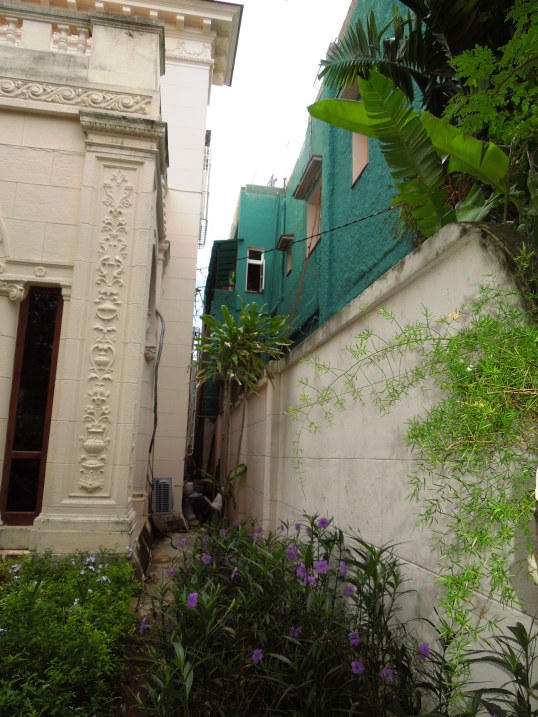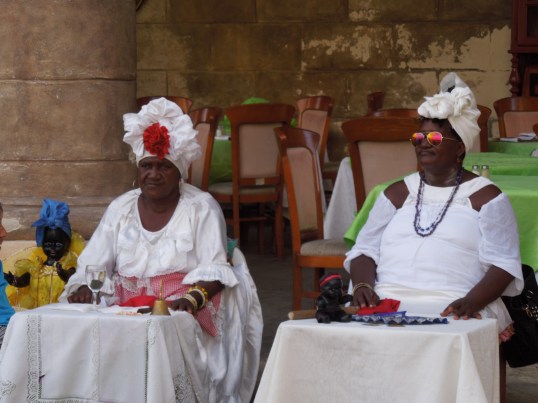Trinidad is a gutsy but laid-back lady of many moods and faces – she has a twinkle in her lovely eye, lives with constant music, she loves Americans, she enjoys a hearty laugh, she offers you her roof-top restaurants and a day at the beach, she has contemporary art for your viewing pleasure hung on old painted fresco walls because she likes the contrast of the very old with the brand new, she becomes one loud and crazy broad when the sun goes down and she dances and sings with wild abandon. You would love her – she will become your best friend in Cuba. She knows everyone!
We took a bus trip across country of such deep green density and beauty that it took our breath away and reminded us of Hawaii…wandering valleys and streams, endless rolling hills toward distant mountains, and finally into the beachy little coastal village of Trinidad. Our Casa Particular hostess had walked to the bus station to meet us, greeted us by name from pictures she had seen of us on Air B&B, and led us back to her home with white grillwork fronting the street and then directly through the door to her life. The magical little world we entered was colorful, to say the least, with grape vine roof over head (and clusters of hanging purple grapes ) on the secluded outdoor patio, a tiny but comfortable air-conditioned bedroom behind a window-paned door, and a newly tiled luxury bathroom, all to ourselves. (see photos in my gallery with this blog)
We could not wait to get acquainted with Trinidad. Such contrasts – the shops with fresh hams hanging in the open windows, the bread delivered daily along each skinny street by a horse-drawn buggy clop-clopping along and a guy yelling “PAN! PAAANNNOOOO!”, the stray dogs and cats, the music coming from several homes at once, the garlic salesman, the produce guy with his cart on the corner, the old ladies hanging out of windows watching as we passed, the 2 amigos posing for my camera as one says “Amigos!” and loops his arm around the others shoulder. It was all as if from a storybook.
Trinidad gave us one particular treasure we will never forget – Manuel G.- a hysterically funny guide who we enlisted to drive us around for about 2 days, including a day trip to sugar plantation country where we saw ruins being restored of an old but very extravagant mansion house accompanied by a slave village just a few hundred yards away from the house in a grove of trees. A tall bell tower for keeping watch on the entire operation was strategically placed so that there were no slave escapees. In the event of that occurrence, the bell was rung and other plantations for miles around knew that there was a runner; everyone dropped what they were doing and gave chase until he or she was tracked down and returned. We saw exactly where the sugar was distilled in gigantic copper pots and the ingenious process that made use of every single part of the sugar cane plant so that wealthy families in America and Europe could enjoy the new imported sweetener that was sugar. When it was discovered that rum could also be manufactured from sugar cane, the wealthy plantation owners became even richer. I will do another blog with pictures of this plantation…
In the several hours spent with Manuel as he drove us around in his AC car, we were treated to some crazy funny conversations about women, marriage, old cars, new cars, and Cuba in general, frank as frank can be in a car where no one could be overheard. You do not want to say anything about the Castro brothers where you might be overheard by the Policia and they are always listening. But with everyone we met, humor is firmly intact in the Cuban people and it is brutally honest at times, because if you are sick and tired of crying and complaining about the dictatorship and the food rations and the impossibility of ever getting off the island, you try your best to make it funny.
I would be glad to provide links to Casa Particulars that we used on this trip if you can manage to get my email address and contact me personally – I do not want to get any Cuban in trouble by mentioning them by name in a blog where I talk so openly about my strong distaste for the dictatorship.
The long, nearly deserted beach just outside downtown Trinidad is gorgeous in its privacy and simplicity. But we were way to busy for the beach. We are both artists. We soak stuff up like giant sponges and take pictures until our arms fall off and we talk in paint color language. The confetti colors of Trinidad are there for us.
For music – and I do mean !MUSIC! – that is authentically Cuban and nearly free almost every night please, please go to Café de la Musica, with its large outdoor stage situated at the side of some wide old stone steps just off the main plaza. You cannot miss it by late afternoon, if you are wandering around looking for a place to have some cocktails and have dinner later. You will hear it! You will feel the ground vibrating! Or just ask anyone… The band and singers number 11 or 12 guys and gals and they are energy personified. You sit at café tables on the steps and order whatever you want to drink and you might be there for hours on end. The people watching is magnificent and the entertainment is the best we had in Cuba. One little snapshot in this gallery does not do it justice.
Our best sunset dinner in Trinidad was eaten on the rooftop terrace of a restaurant near Café de la Musica – there are several rooftop hot spots in that area – just pick one and go with it. They are probably all good. We ate grilled shrimp, onions &black beans with dark rice of some kind, vegetables, shrimp cocktails, bread and salad with flan for dessert. It was delisioso. Of course we continued our research about where to find the best Mojito in all of Cuba, an extensive study requiring hours and hours of dusk time and beyond into the dead of night.
to be continued…..


















































